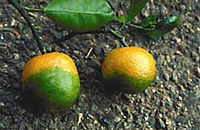
Photo from wikipedia
The Asian citrus psyllid Diaphorina citri Kuwayama is a sap‐sucking hemipteran that serves as a vector for Candidatus Liberibacter asiaticus (CLas), the causal agent of citrus huanglongbing (HLB). Salivary secretions… Click to show full abstract
The Asian citrus psyllid Diaphorina citri Kuwayama is a sap‐sucking hemipteran that serves as a vector for Candidatus Liberibacter asiaticus (CLas), the causal agent of citrus huanglongbing (HLB). Salivary secretions play critical roles in insect–host plant interactions and are responsible for the establishment of insect herbivory. In the present study, we aim to identify the major proteins in D. citri saliva. Saliva proteins are collected from the artificial diet upon D. citri feeding. Collected proteins are concentrated, filtered, digested and then analyzed using liquid chromatography‐tandem spectrometry (MS/MS). The MS/MS data are then analyzed by searching the D. citri genome deposited in the NCBI. Eighty‐nine proteins are identified in D. citri saliva. Eighty‐six of these proteins are from D. citri, whereas three proteins are from Wolbachia endosymbiont. The proteins identified belong to several functional groups, including enzymes, cytoskeletal proteins, sheath proteins, receptor proteins, transporter proteins, chromatin‐, RNA‐ and DNA‐binding proteins, and other proteins. These proteins could be involved in many key functions, including detoxification of plant defencee compounds and suppression of plant defence, as well as facilitation of stylet penetration, sap sucking and digestion. The identification of these proteins is an essential step for the understanding of D. citri–plant interactions. The identification of key enzymes in the saliva of D. citri could lead to a discovery of proper inhibitors that disrupt its feeding, consequently preventing the spread of the HLB pathogen.
Journal Title: Physiological Entomology
Year Published: 2018
Link to full text (if available)
Share on Social Media: Sign Up to like & get
recommendations!